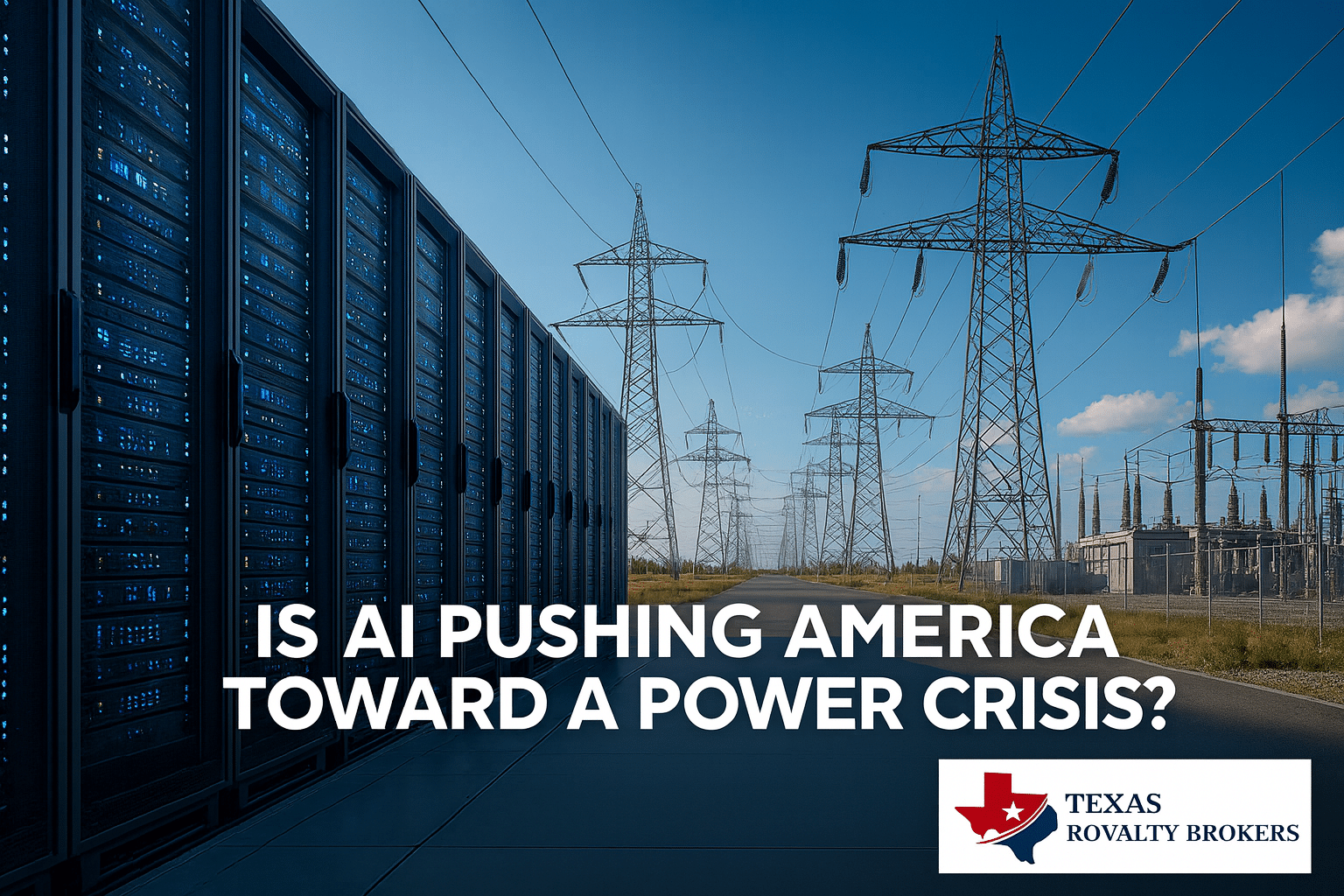Why Texas Royalty Brokers?
sellers
Buyers
State Specific Guides
Resources
Is AI Pushing America Toward a Power Crisis? New Data Suggests It Might Be
- Indiana dedicates more electricity to AI than any other state, with data centers consuming nearly half of the local energy output.
- Texas hosts the most AI facilities with 17 clusters, but their massive power grid keeps AI’s share at 15% of the state’s power generation.
- Wisconsin’s single AI facility uses a quarter of the state’s electricity, consuming 15.8 million MWh yearly from only one location.
ChatGPT alone uses enough electricity daily to power 33K US homes, highlighting AI’s growing energy consumption levels. A new study by mineral rights brokerage firm Texas Royalty Brokers measured AI energy demands across America to find which states dedicate the largest portions of their electricity to artificial intelligence.
The research used data from Epoch AI’s global compute infrastructure tracker, which contains more than 700 AI data center entries worldwide. From this dataset, the study extracted and analyzed only the US-based facilities, identifying 83 major AI computing sites across the country. Their electricity use was estimated using available power capacity figures and GPU hardware data, then compared with each state’s total power output to calculate how much of each state’s electricity is used by AI.
| State (Full Name) | Clusters (# of sites) | Annual Energy Consumption at Full Load (MWh) | Net generation (MWh) | AI Share of Annual Energy |
| Indiana | 3.00 | 42.5 M | 90.0 M | 47.2 % |
| Tennessee | 4.00 | 23.5 M | 77.8 M | 30.2 % |
| Wisconsin | 1.00 | 15.8 M | 62.5 M | 25.2 % |
| Louisiana | 1.00 | 19.8 M | 97.8 M | 20.3 % |
| North Dakota | 1.00 | 6.6 M | 42.1 M | 15.6 % |
| Texas | 17.00 | 80.3 M | 547.3 M | 14.7 % |
| Ohio | 4.00 | 16.4 M | 133.2 M | 12.3 % |
| Nebraska | 3.00 | 2.2 M | 39.4 M | 5.6 % |
| Georgia | 2.00 | 6.3 M | 129.2 M | 4.9 % |
| New Jersey | 2.00 | 2.6 M | 64.2 M | 4.1 % |
| Oregon | 2.00 | 1.6 M | 61.7 M | 2.6 % |
Here’s a look at the top 10 US states where AI consumes the largest share of electricity:You can access the complete research findings here.
Indiana allocates more electricity to AI operations than any other state in the US. Local AI data centers consume roughly 47% of Indiana’s total power output, nearly seven times higher than the national average. The state hosts three major AI clusters, which together use about 42.5 million megawatt-hours (MWh) annually, nearly half of Indiana’s total 90M MWh electricity production. On average, each cluster draws around 14.2M MWh per year, making them one of the most energy-demanding AI centers in the country.
Tennessee takes second place, as AI facilities here consume 30% of the state’s electricity. Tennessee produces 77.8M megawatt-hour of power, and has 4 data centers that require 23.5M MWh each year. Despite having more clusters than Indiana, Tennessee’s AI hubs consume 3 times less energy on average. Though the AI share still represents nearly a third of the state’s entire power output.
Wisconsin holds third position with a single AI center consuming 25% of the state’s power capacity. This cluster utilizes 15.8M MWh annually, a large part of Wisconsin’s 62.5M MWh production. The state’s smaller power grid also amplifies the overall impact, as this one AI site alone runs on more electricity than Nebraska’s three clusters combined (2.2M MWh total).
Louisiana comes in fourth, also operating one AI cluster that uses 20% of the state’s electricity. This hyperscale data center consumes 19.8M MWh from Louisiana’s 97.8 million MWh annual supply, the highest single-cluster usage in the study. With this, Louisiana’s AI computing exceeds the combined consumption of all AI data centers in Georgia and New Jersey.
North Dakota comes in fifth place as AI operations take up more than 15% of the energy. The state’s single cluster requires 6.6M MWh yearly from the available 42.1 million MWh of power, the smallest grid among the top 10 states. While North Dakota’s AI facility uses less total energy than those in the top four states, it still consumes a large share of the state’s limited electricity supply.
Texas ranks sixth, hosting the most AI hubs in the country. The state’s 17 clusters consume 80.3M MWh annually, representing nearly 15% of Texas’s massive 547.3M MWh output, making it the largest power grid in the US. Texas leads in total AI energy consumption, using nearly double Indiana’s 42.5 million MWh, yet the percentage remains lower due to the state’s enormous electricity capacity.
Ohio takes seventh position with AI using 12% of state electricity. The state’s 4 facilities take up 16.4M MWh from Ohio’s 133.2 million MWh annual production. Local AI centers average 4.10M MWh each, similar to Texas’s levels but with a smaller total grid to handle the demand. Still, this leaves a large share of Ohio’s power for other uses, meaning that the state has enough capacity to potentially host more clusters in the future.
Next on the list is Nebraska, where 3 AI facilities consume 5.5% of the state’s power. These clusters pull 2.2M MWh from Nebraska’s 39.4 million MWh grid, the lowest total AI consumption in the study. Each cluster here averages just 0.73M megawatt-hour usage annually, also making them less energy-demanding than other data centers. Despite this, Nebraska’s smaller power output means this AI computing still eats up a significant energy share here.
Georgia comes in ninth with 2 AI clusters drawing almost 5% of state electricity. These facilities consume 6.3M MWh annually from local 129.2M MWh production. Georgia’s clusters average 3.15M MWh each, more than triple Nebraska’s per-cluster consumption. Although the state’s larger power grid helps dilute the impact, leaving much of the electricity for non-AI uses.
New Jersey completes the top 10 with AI facilities using 4% of local power output. The state’s 2 clusters require 2.6M MWh from New Jersey’s 64.2M megawatt-hour annual production. This is around the same as what similar AI centers consume in Nebraska. However, like in the case of Georgia, New Jersey handles the AI compute demand better due to its higher power output.
“Global AI electricity consumption doubled every six months during the last two years, growing faster than any technology in history,” says Eric Winegar, Managing Partner at Texas Royalty Brokers. “The challenge intensifies as next-generation AI models require 10 times more power than current versions. By 2030, it is actually estimated that AI could consume 800 terawatt-hours annually, equal to Japan’s entire electricity usage. The US currently leads global AI development with the most advanced models, but maintaining this edge requires massive infrastructure investment. We see how much share the AI operations are already taking from some of the state’s power output. Without grid expansions, America risks losing its AI advantage.”




